
Финансовый учет. Ридер
.pdf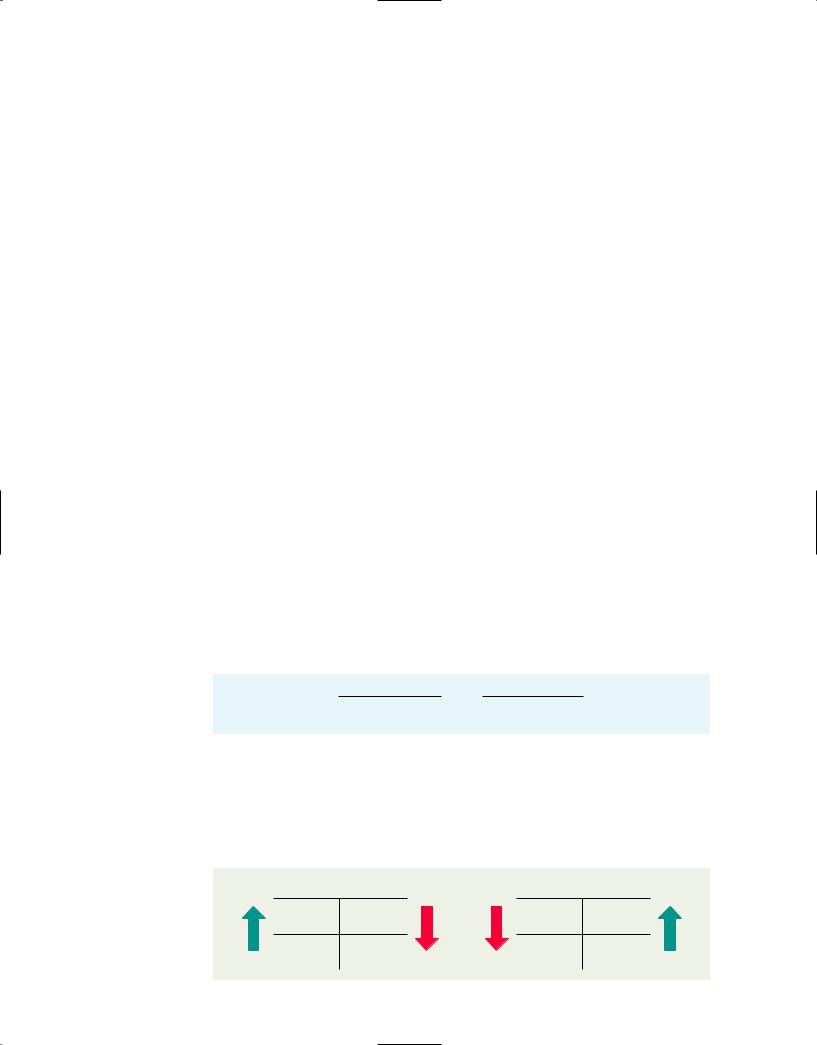
240
112 chapter 3 The Accounting Information System
International Note Rules for accounting for specific events sometimes differ across countries. For example, European companies rely less on historical cost and more on fair value than U.S. companies. Despite the differences, the double-entry accounting system is the basis of accounting systems worldwide.
Every positive item in the tabular summary represents a receipt of cash; every negative amount represents a payment of cash. Notice that in the account form we record the increases in cash as debits, and the decreases in cash as credits. For example, the $10,000 receipt of cash (in red) is debited to Cash, and the$5,000 payment of cash (in blue) is credited to Cash.
Having increases on one side and decreases on the other reduces recording errors and helps in determining the totals of each side of the account as well as the account balance. The balance is determined by netting the two sides (subtracting one amount from the other). The account balance, a debit of $15,200, indicates that Sierra had $15,200 more increases than decreases in cash. That is, since it started with a balance of zero, it has $15,200 in its Cash account.
DEBIT AND CREDIT PROCEDURES
Each transaction must affect two or more accounts to keep the basic accounting equation in balance. In other words, for each transaction, debits must equal credits. The equality of debits and credits provides the basis for the doubleentry accounting system.
Under the double-entry system, the two-sided effect of each transaction is recorded in appropriate accounts. This system provides a logical method for recording transactions. The double-entry system also helps to ensure the accuracy of the recorded amounts and helps to detect errors such as those at Fidelity Investments as discussed in the Feature Story. If every transaction is recorded with equal debits and credits, then the sum of all the debits to the accounts must equal the sum of all the credits. The double-entry system for determining the equality of the accounting equation is much more efficient than the plus/minus procedure used earlier.
Dr./Cr. Procedures for Assets and Liabilities
In Illustration 3-5 for Sierra Corporation, increases in Cash—an asset—were entered on the left side, and decreases in Cash were entered on the right side. We know that both sides of the basic equation (Assets Liabilities Stockholders’ Equity) must be equal. It therefore follows that increases and decreases in liabilities will have to be recorded opposite from increases and decreases in assets. Thus, increases in liabilities must be entered on the right or credit side, and decreases in liabilities must be entered on the left or debit side. The effects that debits and credits have on assets and liabilities are summarized in Illustration 3-6.
Illustration 3-6 Debit and credit effects—assets and liabilities
Debits |
Credits |
Increase assets |
Decrease assets |
Decrease liabilities |
Increase liabilities |
Illustration 3-7 Normal balances—assets and liabilities
Asset accounts normally show debit balances. That is, debits to a specific asset account should exceed credits to that account. Likewise, liability accounts normally show credit balances. That is, credits to a liability account should exceed debits to that account. The normal balances may be diagrammed as in Illustration 3-7.
Assets |
Liabilities |
||
Debit for |
Credit for |
Debit for |
Credit for |
increase |
decrease |
decrease |
increase |
Normal |
|
|
Normal |
balance |
|
|
balance |
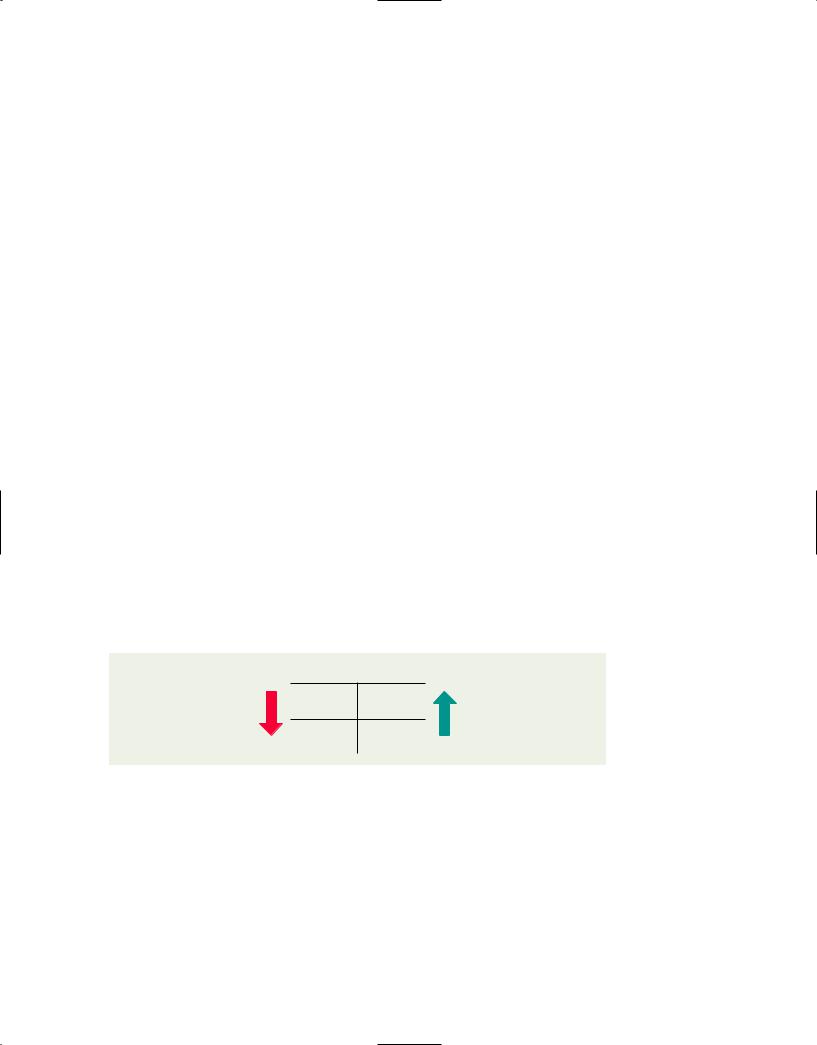
241
The Account 113
Knowing which is the normal balance in an account may help when you are trying to identify errors. For example, a credit balance in an asset account, such as Land, or a debit balance in a liability account, such as Salaries Payable, usually indicates errors in recording. Occasionally, however, an abnormal balance may be correct. The Cash account, for example, will have a credit balance when a company has overdrawn its bank balance (written a check that “bounced”). In automated accounting systems, the computer is programmed to flag violations of the normal balance and to print out error or exception reports. In manual systems, careful visual inspection of the accounts is required to detect normal balance problems.
Dr./Cr. Procedures for Stockholders’ Equity
In Chapter 1, we indicated that stockholders’ equity is comprised of two parts: common stock and retained earnings. In the transaction events earlier in this chapter, you saw that revenues, expenses, and the payment of dividends affect retained earnings. Therefore, the subdivisions of stockholders’ equity are: common stock, retained earnings, dividends, revenues, and expenses.
COMMON STOCK. Common stock is issued to investors in exchange for the stockholders’ investment. The common stock account is increased by credits and decreased by debits. For example, when cash is invested in the business, cash is debited and common stock is credited. The effects of debits and credits on the common stock account are shown in Illustration 3-8.
Helpful Hint The normal balance is the side where increases in the account are recorded.
|
Debits |
|
Credits |
|
Illustration 3-8 Debit |
|
and credit effects—Common |
||||
|
Decrease Common Stock |
Increase Common Stock |
Stock |
||
|
|
|
|
|
|
The normal balance in the Common Stock account may be diagrammed as in Illustration 3-9.
Common Stock |
Illustration 3-9 Normal |
balance—Common Stock |
Debit for Credit for decrease increase
Normal balance
RETAINED EARNINGS. Retained earnings is net income that is retained in the business. It represents the portion of stockholders’ equity that has been accumulated through the profitable operation of the company. Retained earnings is increased by credits (for example, by net income) and decreased by debits (for example, by a net loss), as shown in Illustration 3-10.
|
Debits |
Credits |
|
Illustration 3-10 Debit |
|
|
and credit effects—Retained |
||||
Decrease Retained Earnings |
Increase Retained Earnings |
Earnings |
|||
|
|
|
|
|
|
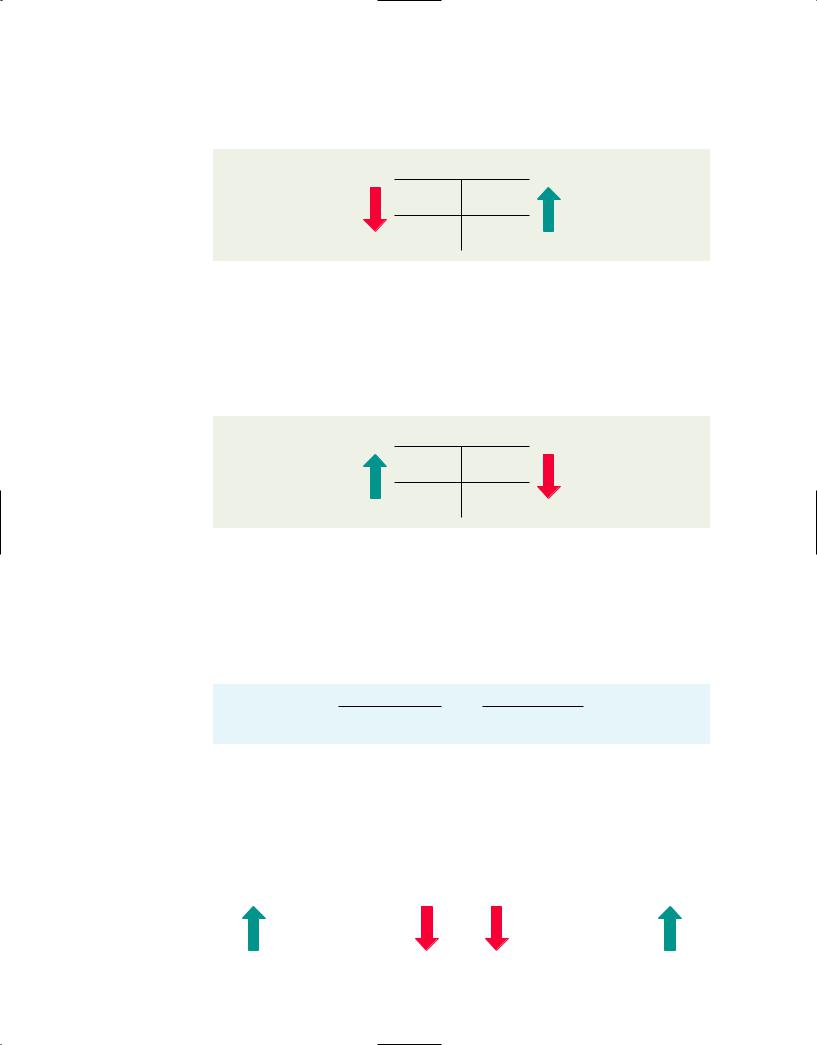
242
114 chapter 3 The Accounting Information System
Illustration 3-11 Normal balance—Retained Earnings
The normal balance for Retained Earnings may be diagrammed as in Illustration 3-11.
Retained Earnings
Debit for Credit for decrease increase
Normal balance
Illustration 3-12 Normal balance—Dividends
DIVIDENDS. A dividend is a distribution by a corporation to its stockholders. The most common form of distribution is a cash dividend. Dividends result in a reduction of the stockholders’ claims on retained earnings. Because dividends reduce stockholders’ equity, increases in the Dividends account are recorded with debits. As shown in Illustration 3-12, the Dividends account normally has a debit balance.
Dividends
Debit for |
Credit for |
increase |
decrease |
Normal |
|
balance |
|
REVENUES AND EXPENSES. When a company earns revenues, stockholders’ equity is increased. Revenue accounts are increased by credits and decreased by debits.
Expenses decrease stockholders’ equity. Thus, expense accounts are increased by debits and decreased by credits. The effects of debits and credits on revenues and expenses are shown in Illustration 3-13.
Illustration 3-13 Debit and credit effects—revenues and expenses
Debits |
Credits |
Decrease revenue |
Increase revenue |
Increase expenses |
Decrease expenses |
Credits to revenue accounts should exceed debits; debits to expense accounts should exceed credits. Thus, revenue accounts normally show credit balances, and expense accounts normally show debit balances. The normal balances may be diagrammed as in Illustration 3-14.
Illustration 3-14 Normal |
|
|
|
|
|
|
|
balances—revenues and |
|
Expenses |
|
Revenues |
|||
expenses |
|
Debit for |
Credit for |
|
Debit for |
Credit for |
|
|
|
|
|||||
|
|
increase |
decrease |
|
decrease |
increase |
|
|
|
Normal |
|
|
|
Normal |
|
|
|
balance |
|
|
|
balance |
|
|
|
|
|
|
|
|
|
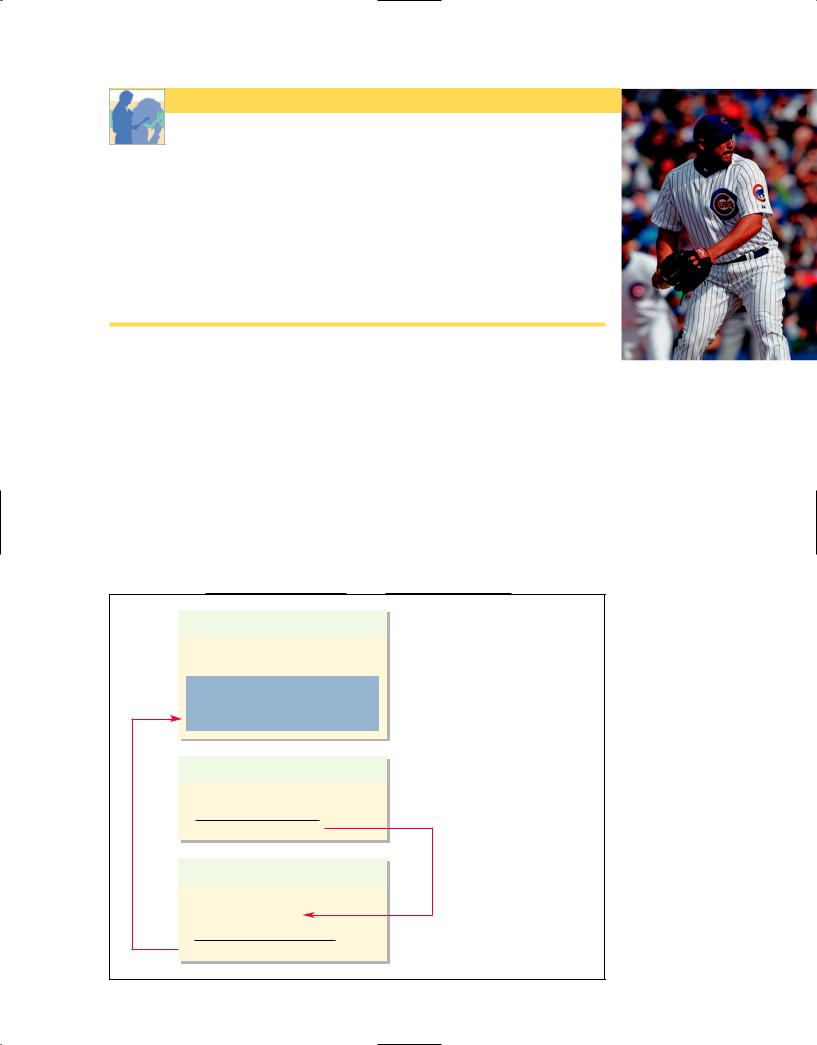
243
The Account 115
Investor Insight
Keeping Score
The Chicago Cubs baseball team has these major revenue and expense
accounts:
Revenues |
Expenses |
Admissions (ticket sales) |
Players’ salaries |
Concessions |
Administrative salaries |
Television and radio |
Travel |
Advertising |
Ballpark maintenance |
|
|
?Do you think that the Chicago Bears football team would be likely to have the same major revenue and expense accounts as the Cubs? (See page 158.)
STOCKHOLDERS’ EQUITY RELATIONSHIPS
Companies report the subdivisions of stockholders’ equity in various places in the financial statements:
•Common stock and retained earnings: in the stockholders’ equity section of the balance sheet.
•Dividends: on the retained earnings statement.
•Revenues and expenses: on the income statement.
Dividends, revenues, and expenses are eventually transferred to retained earnings at the end of the period. As a result, a change in any one of these three items affects stockholders’ equity. Illustration 3-15 shows the relationships of the accounts affecting stockholders’ equity.
Balance Sheet
Assets
Liabilities
Stockholder’s equity
Common stock  Investments by stockholders Retained earnings
Investments by stockholders Retained earnings Net income retained in the business
Net income retained in the business
Income Statement
Revenues |
Less: Expenses |
Net income or net loss |
Retained Earnings Statement |
Begining retained earnings |
Add: Net income |
Less: Dividends
Ending retained earnings
Illustration 3-15
Stockholders’ equity relationships
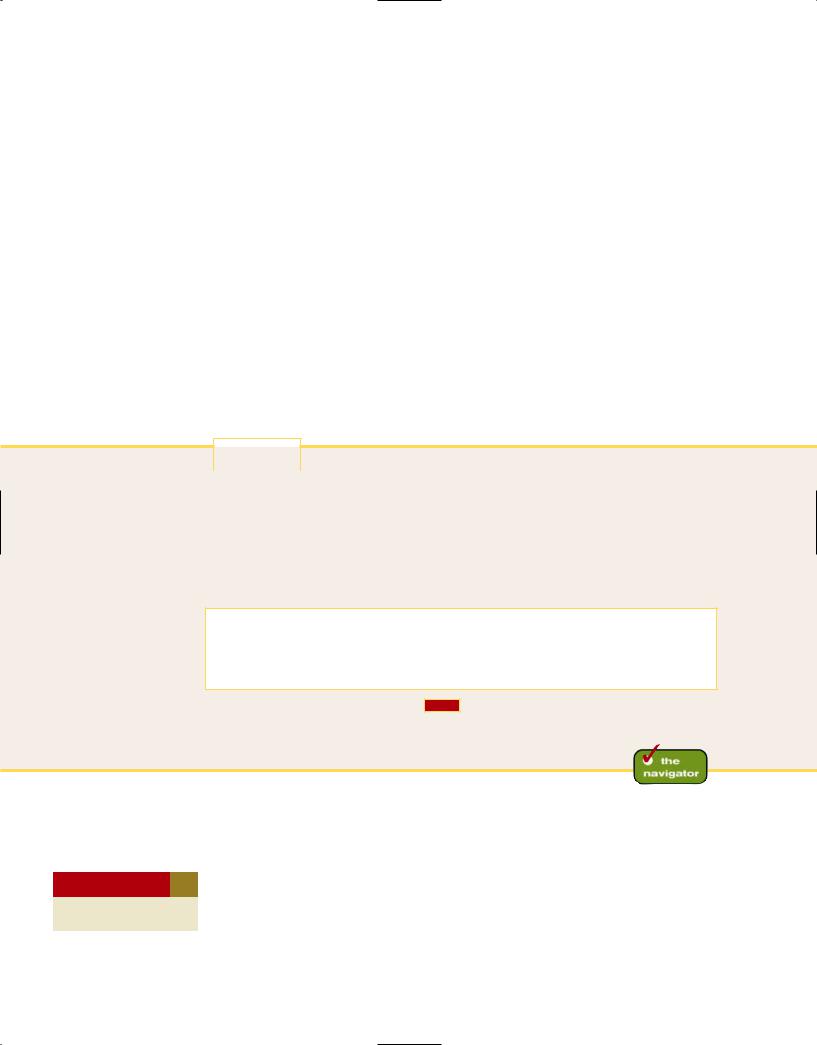
244
116 chapter 3 The Accounting Information System
SUMMARY OF DEBIT/CREDIT RULES
Illustration 3-16 summarizes the debit/credit rules and effects on each type of account. Study this diagram carefully. It will help you understand the fundamentals of the double-entry system. No matter what the transaction, total debits must equal total credits in order to keep the accounting equation in balance.
Illustration 3-16 Summary of debit/credit rules
Basic |
Assets |
= Liabilities + |
|
|
|
|
|
|
|
|
Stockholders’ Equity |
|
|
|
|
|
|
|
|||||||||||||||||
Equation |
|
|
|
|
|
|
|
|
|
|
|
|
|
|
|
||||||||||||||||||||
|
|
|
|
|
|
|
|
|
⎪ ⎪ ⎪ ⎪ ⎪ ⎪ ⎪ ⎪ ⎪ ⎪ ⎪ ⎪ ⎪ ⎪ ⎪ ⎪ ⎨ ⎪ ⎪ ⎪ ⎪ ⎪ ⎪ ⎪ ⎪ ⎪ ⎪ ⎪ ⎪ ⎪ ⎪ ⎪ ⎪ ⎧ |
||||||||||||||||||||||||||
|
|
|
|
|
|
|
|
|
|
|
|||||||||||||||||||||||||
Expanded |
|
|
|
|
|
|
|
|
|
|
|
|
|
|
|
|
|
|
|
|
|
|
|
|
|
|
|
|
|
|
|
|
|
|
|
|
Assets |
|
= |
|
Liabilities |
|
+ |
|
|
Common |
|
+ |
|
Retained |
|
– |
|
Dividends |
|
+ |
|
Revenues |
|
– |
|
Expenses |
|
||||||||
|
|
|
|
|
|
|
|
|
|
|
|
|
|||||||||||||||||||||||
Basic Equation |
|
|
|
|
|
|
Stock |
|
|
Earnings |
|
|
|
|
|
|
|
||||||||||||||||||
Debit / Credit |
|
Dr. |
Cr. |
|
|
|
Dr. |
Cr. |
|
|
|
|
Dr. |
Cr. |
|
|
|
Dr. |
Cr. |
|
|
|
Dr. |
Cr. |
|
|
|
Dr. |
Cr. |
|
|
|
Dr. |
Cr. |
|
|
+ |
– |
|
|
|
– |
+ |
|
|
|
|
– |
+ |
|
|
|
– |
+ |
|
|
|
+ |
– |
|
|
|
– |
+ |
|
|
|
+ |
– |
|
|
Rules |
|
|
|
|
|
|
|
|
|
|
|
|
|
|
|
|
|
|
|
|
|
|
|
|
|
|
|
|
|
|
|
|
|
|
|
|
|
|
|
|
|
|
|
|
|
|
|
|
|
|
|
|
|
|
|
|
|
|
|
|
|
|
|
|
|
|
|
|
|
|
|
before you go on...
DEBITS AND CREDITS FOR BALANCE SHEET ACCOUNTS
Action Plan
•First identify asset accounts for each different type of asset invested in the business.
•Then identify liability accounts for debts incurred by the business.
•Remember that Hair It Is Inc. will need only one stockholders’ equity account for common stock when it begins the business. The other stockholders’ equity accounts will be needed only after the business is operating.
 Kate Browne, president of Hair It Is Inc., has just rented space in a shopping mall for the purpose of opening and operating a beauty salon. Long before opening day and before purchasing equipment, hiring assistants, and remodeling the space, Kate was strongly advised to set up a double-entry set of accounting records in which to record all of her business transactions.
Kate Browne, president of Hair It Is Inc., has just rented space in a shopping mall for the purpose of opening and operating a beauty salon. Long before opening day and before purchasing equipment, hiring assistants, and remodeling the space, Kate was strongly advised to set up a double-entry set of accounting records in which to record all of her business transactions.
Identify the balance sheet accounts that Hair It Is Inc. will likely need to record the transactions necessary to establish and open for business. Also, indicate whether the normal balance of each account is a debit or a credit.
Solution
Hair It Is Inc. would likely need the following accounts in which to record the transactions necessary to establish and ready the beauty salon for opening day: Cash (debit balance); Equipment (debit balance); Supplies (debit balance); Accounts Payable (credit balance); Notes Payable (credit balance), if the business borrows money; and Common Stock (credit balance).
Related exercise material: BE3-4, BE3-5, Do it! 3-2, and E3-7.
Steps in the Recording Process
study objective 4
Identify the basic steps in the recording process.
Although it is possible to enter transaction information directly into the accounts, few businesses do so. Practically every business uses these basic steps in the recording process:
1.Analyze each transaction in terms of its effect on the accounts.
2.Enter the transaction information in a journal.
3.Transfer the journal information to the appropriate accounts in the ledger.

245
Steps in the Recording Process 117
The actual sequence of events begins with the transaction. Evidence of the transaction comes in the form of a source document, such as a sales slip, a check, a bill, or a cash register tape. This evidence is analyzed to determine the effect of the transaction on specific accounts. The transaction is then entered in the journal. Finally, the journal entry is transferred to the designated accounts in the ledger. The sequence of events in the recording process is shown in Illustration 3-17.
Invoice
The Recording Process
JOURNAL
Illustration 3-17 The recording process
JOURNAL
LEDGER |
|
|
ASSETS |
LIABILITIES |
|
|
||
Stockhold |
ers’ |
Equity |
Analyze each transaction |
Enter transaction in a journal |
Transfer journal information |
|
|
to ledger accounts |
THE JOURNAL
Transactions are initially recorded in chronological order in journals before they are transferred to the accounts. For each transaction the journal shows the debit and credit effects on specific accounts. (In a computerized system, journals are kept as files, and accounts are recorded in computer databases.)
Companies may use various kinds of journals, but every company has at least the most basic form of journal, a general journal. The journal makes three significant contributions to the recording process:
1.It discloses in one place the complete effect of a transaction.
2.It provides a chronological record of transactions.
3.It helps to prevent or locate errors because the debit and credit amounts for each entry can be readily compared.
Entering transaction data in the journal is known as journalizing. To illustrate the technique of journalizing, let’s look at the first three transactions of Sierra Corporation in equation form.
On October 1, Sierra issued common stock in exchange for $10,000 cash:
study objective 5
Explain what a journal is and how it helps in the recording process.
Ethics Note Business documents provide evidence that transactions actually occurred. International Outsourcing Services, LLC, was accused of submitting fraudulent documents (store coupons) to companies such as Kraft Foods and PepsiCo for reimbursement of as much as $250 million. Ensuring that all recorded transactions are backed up by proper business documents reduces the likelihood of fraudulent activity.
|
Assets |
|
Liabilities Stockholders’ Equity |
||||
|
|
|
|
|
|
|
|
|
|
|
|
Common |
|||
|
Cash |
|
|
|
Stock |
|
|
$10,000 |
|
|
$10,000 Issued stock |
||||
|
|
|
|
|
|
|
|

246
118 chapter 3 The Accounting Information System
On October 1, Sierra borrowed $5,000 by signing a note:
Assets Liabilities Stockholders’ Equity
Notes
Cash Payable
$5,000 $5,000
On October 2, Sierra purchased equipment for $5,000:
Assets |
Liabilities Stockholders’ Equity |
Cash Equipment
$5,000 $5,000
Illustration 3-18
Recording transactions in journal form
Sierra makes separate journal entries for each transaction. A complete entry consists of: (1) the date of the transaction, (2) the accounts and amounts to be debited and credited, and (3) a brief explanation of the transaction. These transactions are journalized in Illustration 3-18.
GENERAL JOURNAL
|
Date |
|
Account Titles and Explanation |
|
Debit |
|
Credit |
|
|
|
|
|
|||||
2012 |
|
|
|
|
|
|
|
|
|
Oct. |
1 |
Cash |
|
10,000 |
|
|
|
|
|
|
Common Stock |
|
|
|
10,000 |
|
|
|
|
(Issued stock for cash) |
|
|
|
|
|
|
|
1 |
Cash |
|
5,000 |
|
|
|
|
|
|
Notes Payable |
|
|
|
5,000 |
|
|
|
|
(Issued 3-month, 12% note payable for cash) |
|
|
|
|
|
|
|
2 |
Equipment |
|
5,000 |
|
|
|
|
|
|
Cash |
|
|
|
5,000 |
|
|
|
|
(Purchased equipment for cash) |
|
|
|
|
|
|
|
|
|
|
|
|
|
|
Note the following features of the journal entries.
1.The date of the transaction is entered in the Date column.
2.The account to be debited is entered first at the left. The account to be credited is then entered on the next line, indented under the line above. The indentation differentiates debits from credits and decreases the possibility of switching the debit and credit amounts.
3.The amounts for the debits are recorded in the Debit (left) column, and the amounts for the credits are recorded in the Credit (right) column.
4.A brief explanation of the transaction is given.
It is important to use correct and specific account titles in journalizing.
Erroneous account titles lead to incorrect financial statements. Some flexibility exists initially in selecting account titles. The main criterion is that each title must appropriately describe the content of the account. For example, a company could use any of these account titles for recording the cost of delivery trucks: Equipment, Delivery Equipment, Delivery Trucks, or Trucks. Once the company chooses the specific title to use, however, it should record under that account title all subsequent transactions involving the account.
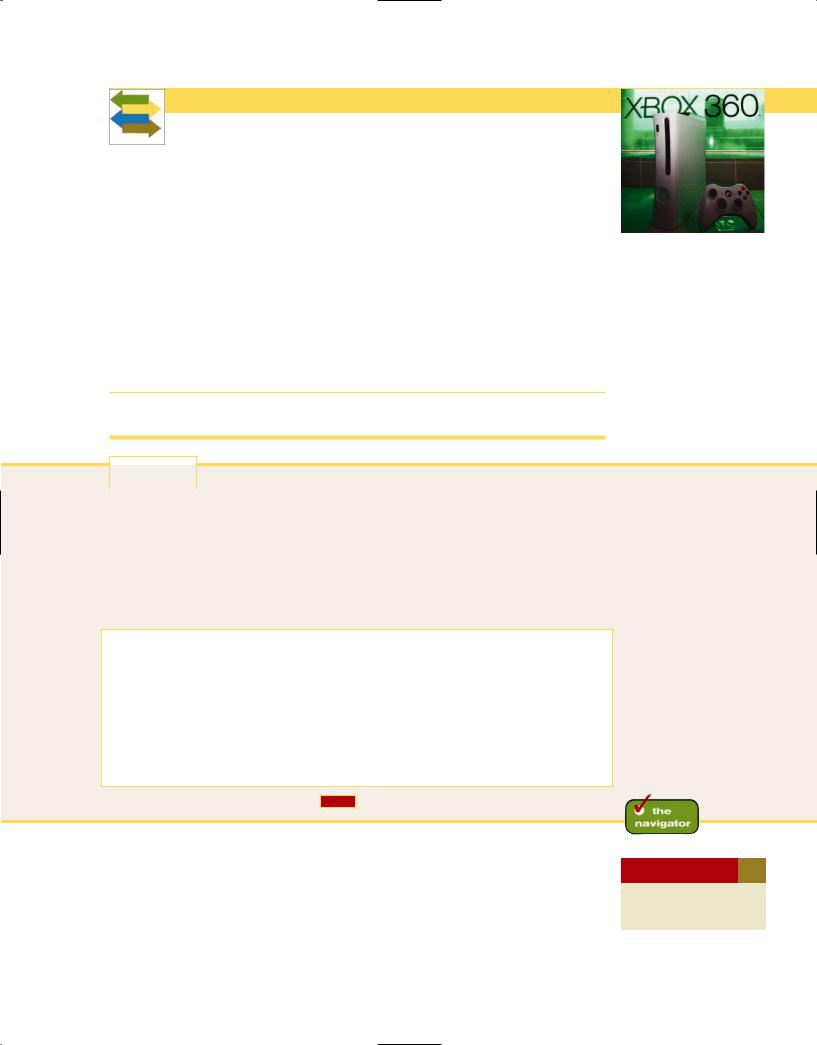
247
Steps in the Recording Process 119
Accounting Across the Organization
Boosting Microsoft’s Profits
Bryan Lee is head of finance at Microsoft’s Home and Entertainment Division. In recent years the division lost over $4 billion, mostly due to losses on the original Xbox videogame player. With the Xbox 360 videogame player, Mr. Lee hoped the division would become profitable. He set strict goals for sales, revenue, and profit. “A manager seeking to spend more on a feature such as a disk drive has to find allies in the group to cut spending elsewhere, or identify new revenue to offset the increase,” he explains.
For example, Microsoft originally designed the new Xbox to have 256 megabytes of memory. But the design department said that amount of memory wouldn’t support the best special effects. The purchasing department said that adding more memory would cost $30—which was 10% of the estimated selling price of $300. But the marketing department “determined that adding the memory would let Microsoft reduce marketing costs and attract more game developers, boosting royalty revenue. It would also extend the life of the console, generating more sales.” Microsoft doubled the memory to 512 megabytes.
Source: Robert A. Guth, “New Xbox Aim for Microsoft: Profitability,” Wall Street Journal (May 24, 2005), p. C1.
?In what ways is this Microsoft division using accounting to assist in its effort to become more profitable? (See page 158.)
before you go on...
 The following events occurred during the first month of business of Hair It Is Inc., Kate Browne’s beauty salon:
The following events occurred during the first month of business of Hair It Is Inc., Kate Browne’s beauty salon:
1.Issued common stock to shareholders in exchange for $20,000 cash.
2.Purchased $4,800 of equipment on account (to be paid in 30 days).
3.Interviewed three people for the position of beautician.
In what form (type of record) should the company record these three activities? Prepare the entries to record the transactions.
Solution
Each transaction that is recorded is entered in the general journal. The three activities are recorded as follows.
1. |
Cash |
|
20,000 |
|
|
|
Common Stock |
|
|
20,000 |
|
|
(Issued stock for cash) |
|
|
|
|
|
|
|
|
||
2. |
Equipment |
|
|
4,800 |
|
|
|
|
|||
|
Accounts Payable |
|
|
|
4,800 |
|
(Purchased equipment on account) |
|
|
|
|
|
|
|
|
|
|
3. |
No entry because no transaction occurred. |
|
|
|
|
JOURNAL ENTRIES
Action Plan
•Record the transactions in a journal, which is a chronological record of the transactions.
•Make sure to provide a complete and accurate representation of the transactions’ effects on the assets, liabilities, and stockholders’ equity of the business.
Related exercise material: BE3-6, BE3-9, Do it! 3-3, E3-6, E3-8, and E3-9.
THE LEDGER
The entire group of accounts maintained by a company is referred to collectively as the ledger. The ledger keeps in one place all the information about changes in specific account balances.
Companies may use various kinds of ledgers, but every company has a general ledger. A general ledger contains all the assets, liabilities, stockholders’ equity, revenue, and expense accounts, as shown in Illustration 3-19 (page 120). Whenever we use the term ledger in this textbook without additional specification, it will mean the general ledger.
study objective 6
Explain what a ledger is and how it helps in the recording process.

248
120 chapter 3 |
The Accounting Information System |
|
|
|
|
|
|
|
|
|
|
|
|
|
|
||||||||||||||||||||
Illustration 3-19 |
The |
|
|
|
|
|
|
|
|
|
|
|
|
|
|
|
|
|
|
|
|
|
|
|
|
|
|
|
|
|
|
|
|
|
|
|
|
|
|
|
|
|
|
|
|
|
|
|
|
|
|
|
|
|
|
|
|
|
|
|
|
|
|
|
|
|
|
|
|
||
general ledger |
|
|
|
|
|
Individual |
|
|
|
|
|
|
Individual |
|
|
|
|
|
|
Individual |
|
|
|||||||||||||
|
|
|
|
|
|
|
|
|
|
|
|
|
|
|
|
|
|||||||||||||||||||
|
|
|
|
|
|
Asset |
|
|
|
|
Liability |
|
|
|
Stockholders’ Equity |
|
|||||||||||||||||||
|
|
|
|
|
|
Accounts |
|
|
|
|
Accounts |
|
|
|
|
|
|
Accounts |
|
||||||||||||||||
|
|
|
|
|
|
|
|
|
|
|
|
|
|
|
|
|
|
|
|
|
|
|
|
|
|
|
|
|
|
|
|
|
|
|
|
|
|
|
Equipment |
|
|
|
|
|
|
|
Interest Payable |
Salaries Expense |
|||||||||||||||||||||||
|
|
|
|
Land |
|
|
|
|
|
|
|
|
Salaries Payable |
|
|
|
|
|
|
|
|
Service Revenue |
|
|
|
|
|
|
|||||||
|
|
|
|
|
Supplies |
|
|
|
|
|
|
|
|
|
Accounts Payable |
|
|
|
|
|
|
|
|
|
Dividends |
|
|
|
|
|
|
||||
|
|
|
|
|
|
|
|
|
|
|
|
|
|
|
|
|
|||||||||||||||||||
|
|
|
|
|
|
Cash |
|
|
|
|
|
|
|
|
Notes Payable |
|
|
|
|
|
|
|
|
Retained Earnings |
|
|
|
|
|||||||
|
|
|
|
|
|
|
|
|
|
|
|
|
|
|
|
|
|
|
|
||||||||||||||||
|
|
|
|
|
|
|
|
|
|
|
|
|
|
|
|
|
|
|
|
|
|
|
Common Stock |
|
|
|
|||||||||
|
|
|
|
|
|
|
|
|
|
|
|
|
|
|
|
|
|
|
|
|
|
|
|
|
|
|
|
|
|
|
|
||||
|
|
|
|
|
|
|
|
|
|
|
|
|
|
|
|
|
|
|
|
|
|
|
|
|
|
|
|
|
|
|
|
|
|
|
|
|
|
|
|
|
|
|
|
|
|
|
|
|
|
|
|
|
|
|
|
|
|
|
|
|
|
|
|
|
|
|
|
|
|
|
|
|
|
CHART OF ACCOUNTS |
|
|
|
|
|
|
|
|
|
|
|
|
|
|
|
|
|
|
|
|
|
|
|||||||||||
Illustration 3-20 Chart of accounts for Sierra Corporation
The number and type of accounts used differ for each company, depending on the size, complexity, and type of business. For example, the number of accounts depends on the amount of detail desired by management. The management of one company may want one single account for all types of utility expense. Another may keep separate expense accounts for each type of utility expenditure, such as gas, electricity, and water. A small corporation like Sierra Corporation will not have many accounts compared with a corporate giant like Ford Motor Company. Sierra may be able to manage and report its activities in 20 to 30 accounts, whereas Ford requires thousands of accounts to keep track of its worldwide activities.
Most companies list the accounts in a chart of accounts. They may create new accounts as needed during the life of the business. Illustration 3-20 shows the chart of accounts for Sierra Corporation in the order that they are typically listed (assets, liabilities, stockholders’ equity, revenues, and expenses). Accounts shown in red are used in this chapter; accounts shown in black are explained in later chapters.
|
|
|
|
|
|
|
|
|
|
|
|
|
|
|
|
|
|
SIERRA CORPORATION—CHART OF ACCOUNTS |
|
|
|
||||
|
|
|
|
|
|
|
Stockholders’ |
|
|
|
|
|
|
|
Assets |
|
Liabilities |
|
Equity |
|
Revenues |
|
Expenses |
|
|
|
Cash |
Notes Payable |
Common Stock |
Service Revenue Salaries Expense |
||||||||
|
Accounts Receivable |
Accounts Payable |
Retained Earnings |
|
Supplies Expense |
|||||||
|
|
Supplies |
Interest Payable |
Dividends |
|
Rent Expense |
||||||
|
|
Prepaid Insurance |
Unearned |
Income Summary |
|
Insurance Expense |
||||||
|
|
Equipment |
Service Revenue |
|
|
|
Interest Expense |
|||||
|
|
Accumulated Depreciation— |
Salaries Payable |
|
|
|
Depreciation Expense |
|||||
|
|
Equipment |
|
|
|
|
|
|
|
|
||
|
|
|
|
|
|
|
|
|
|
|
|
|
study objective 7
Explain what posting is and how it helps in the recording process.
POSTING
The procedure of transferring journal entry amounts to ledger accounts is called posting. This phase of the recording process accumulates the effects of journalized transactions in the individual accounts. Posting involves these steps:
1.In the ledger, enter in the appropriate columns of the debited account(s) the date and debit amount shown in the journal.
2.In the ledger, enter in the appropriate columns of the credited account(s) the date and credit amount shown in the journal.
The Recording Process Illustrated
Illustrations 3-21 through 3-31 on the following pages show the basic steps in the recording process using the October transactions of Sierra Corporation. Sierra’s accounting period is a month. A basic analysis and a debit–credit analysis precede the journalizing and posting of each transaction. Study these transaction

249
The Recording Process Illustrated 121
analyses carefully. The purpose of transaction analysis is first to identify the type of account involved and then to determine whether a debit or a credit to the account is required. You should always perform this type of analysis before preparing a journal entry. Doing so will help you understand the journal entries discussed in this chapter as well as more complex journal entries to be described in later chapters.
Accounting Cycle Tutorial
The diagrams in Illustrations 3-21 to 3-31 review the accounting cycle. If you would like additional practice, an Accounting Cycle Tutorial is available on WileyPLUS. The illustration to the left is an example of a screen from the tutorial.
Event 1
Basic
Analysis
Equation
Analysis
Debit–Credit
Analysis
Journal
Entry
Posting
On October 1, stockholders invest $10,000 cash in an outdoor guide service company to be known as Sierra Corporation.
The asset Cash is increased $10,000, and stockholders’ equity (specifically Common Stock) is increased $10,000.
|
|
Assets |
= |
Liabilities + |
Stockholders’ Equity |
||||
|
|
|
|
= |
|
|
|
Common |
|
|
|
Cash |
|
|
|
|
Stock |
|
|
(1) |
+$10,000 |
|
|
|
|
+$10,000 Issued stock |
|||
Debits increase assets: debit Cash $10,000.
Credits increase stockholders’ equity: credit Common Stock $10,000.
|
Oct. 1 |
Cash |
|
10,000 |
|
|||
|
|
Common Stock |
|
|
10,000 |
|||
|
|
(Issued stock for cash) |
|
|
|
|
|
|
|
|
|
|
|
|
|
|
|
|
|
|
|
|
|
|
|
|
|
|
Cash |
|
Common Stock |
||||
|
Oct. 1 |
10,000 |
|
|
|
|
Oct. 1 10,000 |
|
|
|
|
|
|
|
|
|
|
Illustration 3-21
Investment of cash by stockholders
